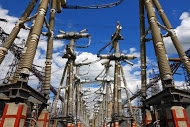
CR Power recurring net profit jumps 4.1% to HKD12.7b
Thanks partly to unexpectedly lower fuel cost.
China Resources Power (CR Power) recently announced its 2014 results, with net profit of HKD9,215mn, down 16.3% y-y.
According to a research note from Nomura, stripping out one-off items such as impairment losses, disposal gains/losses, FV adjustments on financial assets, etc, recurring net profit rose 4.1% y-y to HKD12,723mn, 6.5%/7.3% higher than consensus and Nomura's estimates, respectively.
Nomura believes the beat can be mainly attributed to the larger-than-expected drop in unit fuel costs (12.4% y-y in 2014 versus Nomura's assumption of 10.0% y-y).
Apart from an interim DPS of HKD0.08, CR Power proposed a final DPS of HKD0.70, implying a 40% dividend payout ratio in 2014.
Here's more from Nomura:
Reaffirm Neutral on solid power generation business, but dismal coal segment and a lack of major catalysts such as parent asset injection - We have always appreciated CR Power’s power generation business, which we believe has the best operating efficiency among peers.
However, its coal segment may continue to drag down the company’s overall performance, even with a likely narrowing of operating losses after the significant impairments made in 2014, in our view. Together with a lack of parent asset injection story which we note its peers generally have, we reaffirm our Neutral rating and TP of HKD21.0, implying limited upside of 6.6%.
2014 unit fuel cost down 12.6% y-y; to drop 1.0% y-y in 2015F - With a weak coal price throughout 2014, the company’s standard coal price dropped 10.9% y-y to CNY596.5/ton. Together with a 1.1% drop in coal consumption, unit fuel cost was down 12.6% y-y.
With the company’s expectation of a flat coal price trend in 2015F, as well as a likely 1% drop in the coal consumption rate, CR Power guides for a 1.0% y-y drop in unit fuel cost in 2015F. However, we find guidance to be over-conservative vs CPID’s guidance of a 5% drop y-y, and a 10% drop in spot coal prices, YTD. In our model we currently assume a 3.3% unit fuel cost drop.
2014 power output up 5.1% y-y; 2015F target to increase 10% y-y amid steady capacity addition - With a 16.4% increase in attributable capacity in 2014, being partially offset by a 7.5% decline in utilisation, 2014 gross power generation was up 5.1% y-y.
Heading into 2015F, despite a 5.2% decline in utilisation to 5,050 hours as per the company’s estimates, management is confident of achieving steady power generation growth of c.10%, thanks to capacity addition of 4,410MW and 4,100MW, in 2014 and 2015, respectively.
The company’s 10% power output guidance is lower than our current assumption of 16%, as we expect flat utilisation growth, vs CR Power’s assumption of -5.2%. From a mid-term perspective, CR Power guides for attributable capacity to reach 41,000MW by end-2017F, in line with our current assumption of 41,553MW.























 Advertise
Advertise







